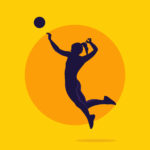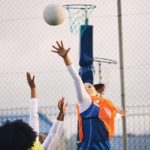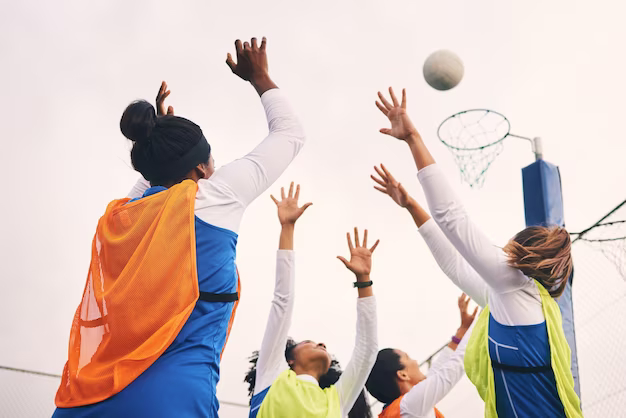Netball is a fast-paced sport that requires players to expertly navigate the court within strict positional rules. To effectively play netball, it is crucial to understand the seven positions on the court, their responsibilities, and where they are permitted to move during gameplay. This allows teams to strategically work the ball down the court to goal while adhering to positioning regulations.
Netball Positions and Areas
| Position | Area | Role |
|---|---|---|
| Goal Shooter (GS) | Goal third only | Main scorer – shoot goals |
| Goal Attack (GA) | Goal third and centre third | Feed GS and create chances |
| Wing Attack (WA) | Centre third and goal third | Transition ball to GS/GA |
| Centre (C) | All areas except goal circles | Playmaker – link defence to attack |
| Wing Defence (WD) | Centre third and defence third | Prevent WA moving forward |
| Goal Defence (GD) | Goal third and centre third | Defend GA, provide backup to GK |
| Goal Keeper (GK) | Goal third only | Shut down GS under post |
Goal Shooter and Goal Attack
The two shooting positions in netball are Goal Shooter (GS) and Goal Attack (GA). These players work cooperatively in the goal circle to shoot goals for their team.
The GS primary role is to convert goals from the passes delivered by the GA. The GS tends to be taller and stronger, using their height close to the post to receive high passes and shoot accurately into the net. The GS cannot leave the goal circle during play. This restrictive positioning allows them to focus on scoring goals from passes in the circle.
The GA has more versatility than the GS. The GA can move freely around the entire goal third to receive passes and assist the GS. Their key role is feeding the ball to the GS in the circle to create scoring opportunities. The GA uses speed and ball skills to lose defenders, drive into the circle, and deliver pinpoint passes to the shooter.
Wing Attack and Wing Defence
On either side of the transverse centre line are the two wing positions of Wing Attack (WA) and Wing Defence (WD). These players operate in the middle third of the court.
The WA is an agile attacking player who provides an important link between the shooters and midcourt. Positioned on the right side of the court, the WA works to keep possession and transition the ball centrally to the shooters. Their movement is restricted to the middle and goal thirds, allowing them to drive both forward and back. The WA uses fast footwork to find space out wide and support the Centre to move the ball forward.
The WD operates on the left side of the court, mirroring the WA. Their focus is defending the opposing WA and forcing turnovers. The WD cannot enter the goal third. This containment positioning enables them to apply pressure and disrupt attacking momentum as the ball transitions into attack. The WD uses their reflexes and speed to intercept passes moving across court.
Centre and Centre Defence
The midcourt positions are Centre (C) and Centre Defence (CD). These two crucial roles connect the attacking and defensive thirds.
The C is the playmaker, able to roam the entire court except for the goal circles. This expansive positioning allows the C to link the defensive and shooting units. They use their strong passing skills and spatial awareness to deliver clean ball movement. The C will often take the centre pass and decide where to distribute the ball to begin building an attacking movement.
The CD directly opposes the C in the middle third. Their role is to break up the C’s playmaking with physical defence and smart interceptions. The CD cannot move into the goal third. By marking the C tightly, the CD looks to force rushed passing errors and win possession back through rebounds or tips. Their ability to read the play and disrupt the C’s rhythm is critical.
Goal Defence and Goal Keeper
The two defensive circles positions are Goal Defence (GD) and Goal Keeper (GK). Stationed under the net, their key focus is preventing goals.
The GD defends the opposing GA. The GD can move between the goal third and centre third. Their positioning provides support to the GK while allowing them to mark and harass the GA as they attempt to feed the shooters. The GD uses their footwork to stick tight to the GA and block passing angles.
The GK is restricted to the goal third. This allows them to concentrate on defending the GS under the post. The GK uses their height and rebounding strength to prevent the GS from receiving passes cleanly or getting free shots at goal. Their role relies on athleticism and decision-making to block shots and win possession back through intercepts and rebounds.
All in all, understanding netball positions and their designated areas on the court is vital to executing gameplay fundamentals like ball movement, defending space, and scoring goals. Learning the roles and responsibilities of each position allows players to make better decisions under pressure and work together cohesively as a tactical unit. With sharp positioning and court awareness, teams can fully unlock the speed, athleticism and strategy that makes netball such an exciting sport.





